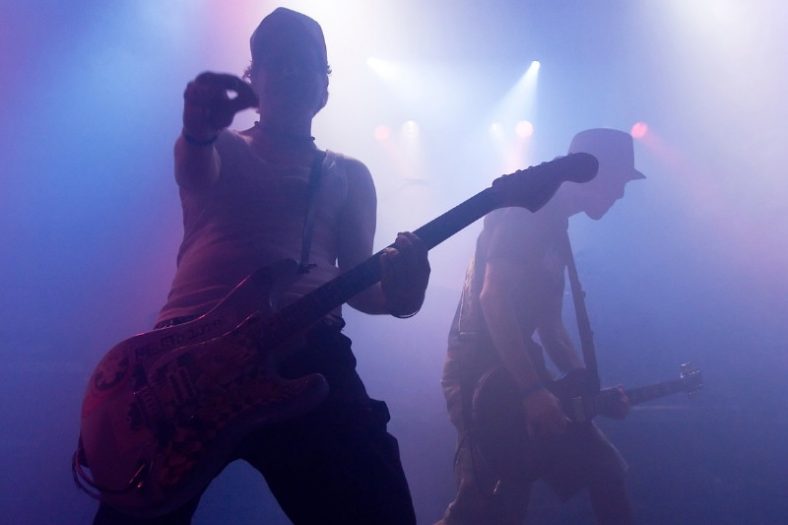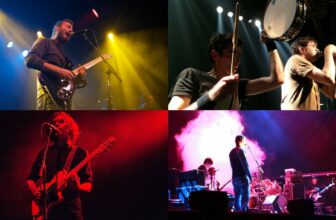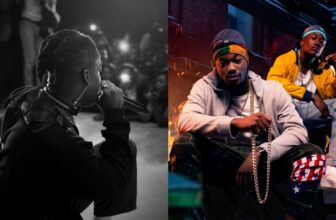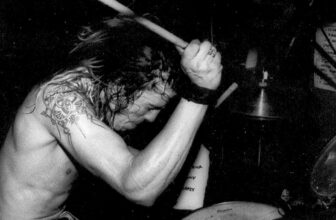What is Ska Music?

Ska is a style of music that originated in Jamaica in the late ’50s and has since been popularized worldwide. Musically, ska is characterized by having a strong offbeat, walking bass lines, a quarter-note guitar rhythm (often with a triplet feel), and a high-energy, fast-paced tempo.
When people think of Jamaican music, they often think of reggae. Well, ska is considered to be reggae’s “older brother!” Its offbeat rhythm undoubtedly inspired the creation of reggae, which is a slower music genre, focused on songwriting instead of dancing.
Like reggae, ska is a Jamaican invention and one of the country’s ultimate cultural exports. Over 50 years since its creation, though, it has evolved into a global style of music that people from all places know and love.
In this article, I’ll start by looking at the history of ska to better understand its scope, influence, and evolution.
Contents
The Origin of Ska
While ska was only invented in the late ’50s, its history dates back to post-World War II Jamaica. The country was introduced to new sounds coming from the United States, and American R&B proved to be particularly important. Suddenly, every Jamaican sound system was playing tunes by artists such as Fats Domino and Willis Jackson.
Influenced by the dancy, fast-paced jazz coming from abroad, pioneers such as Derrick Morgan started releasing singles that sounded like Jamaica’s answer to R&B. By 1962, ska was already considered an established music genre, and its popularization coincided with a major political event: Jamaica’s independence from the United Kingdom.
If reggae was the sound of peace, ska was the sound of freedom. Contrary to Morgan’s R&B-inspired ska sound, The Skatalites were one of the first ska bands to make use of a horn section – which has since become a standard.
Ska music was Jamaica’s most popular style of music until rocksteady and reggae came to the scene. The first wave of ska lasted approximately 10 years and ended in the late ’60s. However, this vibrant music genre was far from over.
Ska in the United Kingdom
Ska music was introduced in Europe in the early ’70s and was rapidly absorbed by the local musicians. It was then a trend known as 2 tone – the second wave of ska – originated in the British city of Coventry. At the time, punk music was the sound of the British youth, and 2-tone can be described as a combination of traditional Jamaican ska with punk’s fast tempo and rebellious attitude.
Just like traditional Jamaican ska, 2 tone was politically significant. It helped to minimize racial tensions in the United Kingdom because it appealed both to the white working-class (especially young workers) and England’s large community of West Indian immigrants.
While there are plenty of popular 2-tone bands from the ’70s, the most influential is The Specials. It’s not only considered to be one of the best ska bands of all time but it also featured the keyboardist Jerry Dammers. As a very successful ska musician and the founder of the 2 Tone Records (that’s where the name of the genre comes from), Dammers is arguably the most important European promoter of the ska sound.
The second wave of ska gave new life to a style of music that was already vanishing from the Jamaican sound systems. And just like traditional ska inspired 2-tone, 2-tone also inspired the third wave of ska, which turned the sound into a global phenomenon.
Third-wave Ska
Throughout the ’80s and ’90s, ska evolved into a global style of music, with successful ska bands appearing everywhere. In the United States, there was The Toasters and Fishbone, in Spain there was the Basque ska-punk band Kortatu, in Australia there was The Allniters, and even Russia had bands like Spitfire and Distemper. Many of these music groups are still active today.
Like 2-tone, third-wave ska was deeply influenced by punk. However, many bands had a more commercial approach to the sound, which allowed ska to step into the mainstream.
This ’80s and ’90s revival also gave way to the creation of a few ska subgenres, many of which were mainly influenced by political ideologies. Christian ska, represented by bands such as The Insyderz, was pretty huge in the early ’00s. Sadly, nazi ska was also very popular among extreme far-right communities.
Sound and Instrumentation
The drums, the bass guitar, and the guitar are essential ska-music instruments. However, many ska acts also feature a horn section with saxophone, trombone, and trumpet. In addition to vocals, these are the most commonly used instruments in ska.
Ska’s sound is mainly characterized by its signature offbeat. Drummers tend to accent the second and fourth beat of a 4/4 measure and are often accompanied by guitar stabs. Ska’s “skank” guitar rhythm is said to be the reason why the genre is called ska, as the guitar makes a sound that resembles “ska ska ska.”
The walking bass line is also a very important characteristic of the ska sound. Walking bass lines started in jazz and are characterized by their forward motion. In a nutshell, a walking bass line is a bass groove of four notes of equal duration per measure. The notes can vary extensively (while they seldom do in ska), but the rhythm is always the same.
Finally, the ska sound is also defined by its politically-conscious lyrics. While some ska artists chose not to tackle pressing social issues, most promoted a certain political ideology. Justice, peace, labor rights, anti-racism, and equality are just some of the themes that inspired ska lyricists throughout the years.
Seminal works of Ska
An overview of ska wouldn’t be complete without a mention of the artists and albums that have best promoted the music genre. These are five of the most influential and revered ska records of all time:
The Skatalites – Ska-Boo-Da-Ba (1966)
Jamaican ska doesn’t get much better than “Ska-Boo-Da-Ba,” released by the iconic The Skatalites in 1966. Arguably the most famous album of traditional ska ever released, this seminal album is praised for its intricate arrangements, flawless guitar work (props to the late great Jerome “Jah Jerry” Haynes), and dynamic horns. If you want to know what the old-school Jamaican ska was all about, “Ska-Boo-Da-Ba” is the best place to start.
The Specials – Specials (1979)
Probably the most famous ska album ever released, “Specials” is the masterpiece of The Specials, the band that most effectively turned 2-tone into a nationwide British phenomenon in the ’70s. Even though “Specials” was the band’s debut album, it was the work of a mature music group with an impressive collection of catchy songs.
The album’s opening tune, “A Message To You Rudy,” is one of the most famous ska songs ever released.
Operation Ivy – Energy (1989)
One of the earliest great acts of the third wave of ska, the American ska-punk band Operation Ivy is one of the best in the subgenre. With that rough, hardcore edge that even the toughest bands in the 2-tone era often missed, “Energy” is the only album ever released by Operation Ivy and it remains a classic today.
The record’s title is perfect too: Operation Ivy’s cult album is a non-stop burst of fast-paced ska grooves with nasty vocals and some pretty cool punk-rock riffs. The band is also huge in the skater’s community.
Catch Twenty-Two – Keasbey Nights (1998)
Ska fans had to wait until 1998 to listen to a band that managed to perfectly encompass the edginess of ska-punk with the horn-driven, jazzy fun of traditional Jamaican ska. In a way, Catch Twenty-Two’s (also known as Catch 22) “Keasbey Nights” is the ultimate summary of everything great about ska.
The horn work in the album is impressive and matches the catchy vocal melodies and unstoppable offbeat drums to perfection. The titular song is two-and-a-half minutes of ska-punk perfection.
Streetlight Manifesto – Everything Goes Numb (2003)
It wouldn’t be fair to cite “Keasbey Nights” without also mentioning Streetlight Manifesto’s brilliant “Everything Goes Numb.” Pretty much like Catch Twenty-Two, this American act managed to combine all the greatest elements of ska in a single, pop-punk package. It’s energetic, horn-driven, and features some crazily-catchy vocal melodies that would’ve made Blink 182 proud.
Streetlight Manifesto’s particularity, though, is the fact they’ve taken a slightly progressive approach to ska. While most ska songs tend to follow a single structure, Streetlight Manifesto explores a more complex style of songwriting and puts some of that old-school New Orleans jazz vibe back into the genre.
Will there be a fourth wave of ska?
Music works in cycles, and it’s reasonable to wonder about the future of ska. Nowadays, it’s fair to say that ska songs rarely play on the radio and that the genre is not as popular in the punk scene as it used to be. However, there’s more than hope for the future of ska.
Some people believe that the 2021 song “The Final Parade,” by The Mighty Mighty Bosstones, is the start of a fourth-wave ska. The tune is characterized by its intricate lyrics and lasts a whopping eight minutes, a complete rarity in the style.
Whether we get to witness the fourth wave of ska or not, one thing’s for sure: this Jamaican-born style of music will continue to influence future generations of musicians. Initially inspired by American R&B artists from the ’50s, ska went from being a Jamaican style of dance music to becoming a worldwide phenomenon.
Conclusion
Ska is a Jamaican-born style of music that has influenced many musicians around the world. Ska has slowly evolved over the years and has become a more popular genre of music. There is a lot of hope for the future of ska, as many people believe that it is slowly making a comeback. This unique genre of music is sure to continue influencing future generations of musicians.





